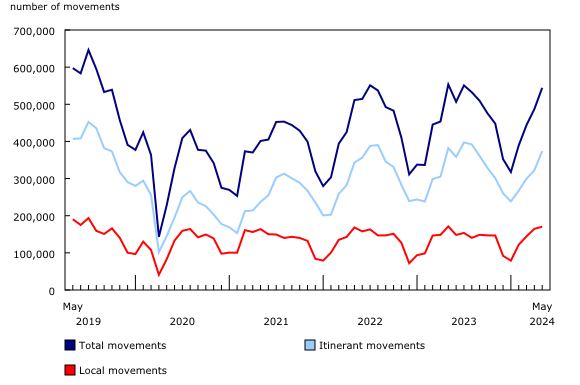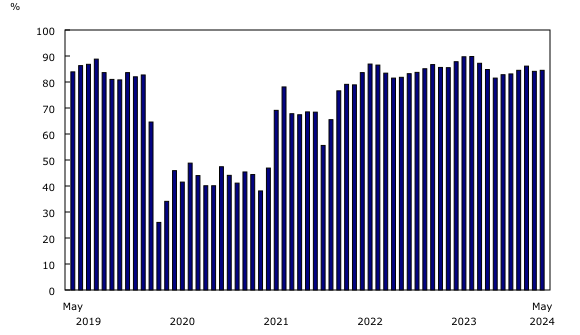Aircraft movement and civil aviation statistics, May 2024
Released: 2024-07-25
Highlights
In May, Canada's major and select small airports recorded a total of 544,313 aircraft movements, down 1.6% from May 2023. Itinerant movements decreased 2.2% year over year to 373,928, while local movements declined 0.5% to 170,385.
At the same time, major Canadian airlines flew 7.3 million passengers on scheduled and charter services in May, with a passenger load factor of 84.5%.
Consult the new Aviation Data Visualization Hub to explore aircraft movement statistics and monthly civil aviation statistics in an interactive format.
Wildfires and the impact on aircraft movements
Based on warmer temperatures and drier spring conditions across parts of the country, Environment and Climate Change Canada indicated a higher level of risk for wildfires for the spring and summer of 2024. Several major fires were reported in May, resulting in evacuation orders being issued for some areas of Western Canada. Specifically, aircraft traffic at Fort McMurray, Alberta, increased by 2,429 movements, compared with May 2023, while Flin Flon, Manitoba, recorded an additional 1,191 movements. The majority of this growth was from small carriers (Level IV to VI), which are used to battle wildfires.
Domestic movements decline in May
In May 2024, domestic movements declined 3.7% year over year to 320,787. In contrast, other international traffic (outside the United States) rose 13.0% to 15,528 from the previous year, while transborder traffic (to and from the United States) increased 6.5% to 37,613. Of these three sectors, other international remained the only one with monthly movements above the pre-COVID-19 pandemic level in May 2019.
The 2.2% year-over-year decrease in total itinerant movements in May marked the third decline since April 2021. The drop was primarily attributable to private operators and carriers classified as Level IV to VI.
For the third consecutive month, airports in British Columbia reported the highest number of aircraft movements, with 153,605 in May 2024, up marginally (+0.7%) from the previous year. Airports in Ontario were the next busiest, with 133,699 movements. Toronto/Lester B. Pearson International remained the busiest airport in Canada with 33,325 movements.
Major airlines' operating and financial statistics
The seven Canadian Level I air carriers flew 7.3 million passengers on scheduled and charter services in May, 12.9% more than in May 2023, when there were six Level I carriers. One Level II air carrier was reclassified to Level I in 2024.
The number of passenger-kilometres in May 2024 was 19.8 billion, with a capacity of 23.4 billion available seat-kilometres. As a result, the passenger load factor (the ratio of passenger-kilometres to available seat-kilometres) was 84.5%, down from 85.5% recorded in the same month one year earlier.
Each passenger travelled an average of 2,725 kilometres in May, up 1.1% from May 2023.
Level I carriers flew 184,000 hours in May 2024 and generated $2.5 billion in total operating revenue.
Did you know we have a mobile app?
Download our mobile app and get timely access to data at your fingertips! The StatsCAN app is available for free on the App Store and on Google Play.
Note to readers
As of reference month January 2024, Statistics Canada publishes a new consolidated monthly release called "Aircraft movement and civil aviation statistics." The new release covers the following survey programs:
- Aircraft movement statistics (survey number 2715, tables 23-10-0296-01 to 23-10-0304-01)
- Monthly civil aviation statistics (survey number 5026, table 23-10-0079-01).
The tables associated with the above survey programs remain unchanged and will be updated as usual. Definitions, data sources and methods for each survey program remain available by accessing each survey's respective number.
Consult the new Aviation Data Visualization Hub to explore data from Aircraft movement statistics and Monthly civil aviation statistics in an interactive format.
The aviation statistics program uses respondent (Monthly civil aviation statistics) and administrative (Aircraft movement statistics) data.
An aircraft movement is defined as a take-off, landing or simulated approach by an aircraft, as defined by NAV CANADA.
An itinerant movement is the initial take-off or the final landing of an aircraft.
A local movement is an aircraft conducting the following airport activities: touch-and-go, stop-and-go, simulated approach without landing, low approach, pull up while on final approach or missed approach. Local movements are often carried out during training flights (touch-and-go), equipment tests, etc.
The Monthly Civil Aviation Survey covers all Canadian Level I air carriers: Air Canada (including Air Canada Rouge), Air Transat, Flair, Jazz, Porter, Sunwing and WestJet (including WestJet Encore and WestJet Link). The number of air carriers increased from six in 2023 to seven in 2024 because one Level II air carrier was reclassified to Level I.
The average passenger trip length is calculated by dividing the number of passenger-kilometres by the number of passengers. Trips across Canada and around the world are included in this calculation.
The data in this monthly release are not seasonally adjusted.
Data are subject to revisions.
Contact information
For more information, or to enquire about the concepts, methods or data quality of this release, contact us (toll-free 1-800-263-1136; 514-283-8300; infostats@statcan.gc.ca) or Media Relations (statcan.mediahotline-ligneinfomedias.statcan@statcan.gc.ca).
- Date modified:



